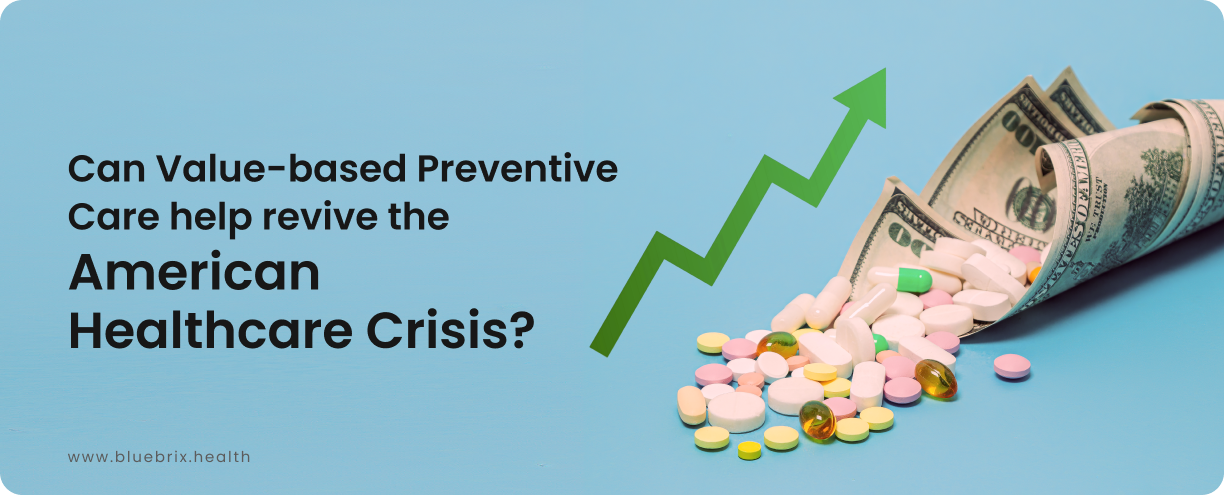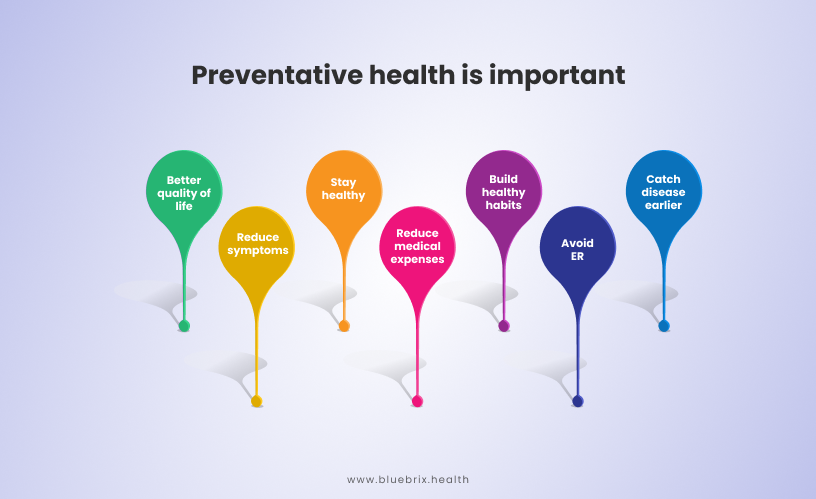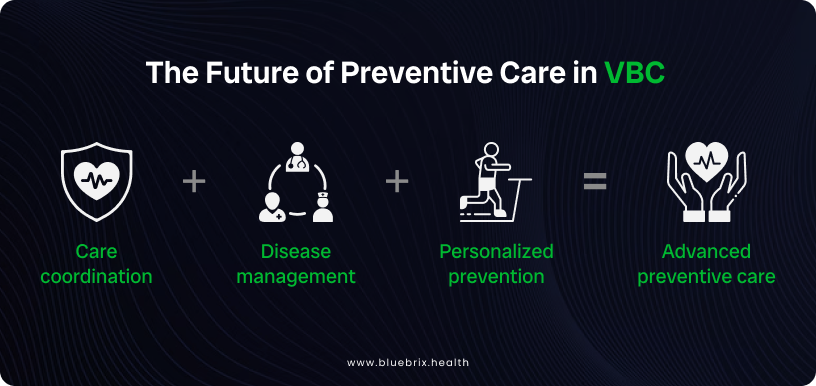Preventive care is often touted as the cornerstone of value-based healthcare, but why does it matter so much today? The American healthcare system is in crisis, plagued by rising costs, chronic diseases, and unsustainable delivery models. This article explores how value-based preventive care could transform outcomes by reducing costs, improving patient satisfaction, and addressing physician burnout. From diabetes prevention programs to leveraging advanced technologies like blueBriX’s solutions, we delve into the opportunities, challenges, and strategies for embracing preventive care as a critical driver of healthcare reform. Read on to discover how we can shift the paradigm and create a healthier, more sustainable future.

“America’s health care system is in crisis precisely because we systematically neglect wellness and prevention.” – Tom Harkin
Tom Harkin’s words strike at the heart of a fundamental issue in modern healthcare which is relevant even today. Despite advancements in medical technology and treatment methodologies, the United States continues to grapple with a healthcare system that prioritizes reactive care over proactive wellness. In the context of value-based care (VBC), preventive care emerges as a transformative approach—offering benefits to providers, payers, and most importantly, patients.
Can America save $100 billion dollars in Diabetic Care?
Preventive care for diabetes, particularly in the early stages (Level 1: Prediabetes), can have a profound impact on reducing healthcare costs in the U.S. by addressing the progression of the disease and mitigating the high expenses associated with complications. Here’s how:
- Cost of Prediabetes Intervention: Individuals with prediabetes have an elevated risk of progressing to Type 2 diabetes, which significantly increases healthcare costs. However, early intervention through lifestyle changes (e.g., diet, exercise, and medication) is much more cost-effective, at about $12,500 per Quality-Adjusted Life Year (QALY). Preventing or delaying the onset of Type 2 diabetes could prevent the subsequent costs associated with treatment, hospitalizations, and management of complications, saving the system billions.
- Escalating Costs with Type 2 Diabetes: As diabetes progresses to Type 2 (Level 2), the costs increase sharply. Medicare beneficiaries aged 65 and older with Type 2 diabetes face an estimated $5,876 in annual costs per person, reflecting not only the direct medical costs but also the added burden of managing chronic conditions like hypertension, kidney disease, and neuropathy. The increase in healthcare spending (7% from 2017 to 2022) highlights the growing burden of diabetes management. Preventing the progression to this stage or reducing the complications associated with it could significantly reduce this financial burden.
- Cost of Diabetes Complications: In the most advanced stage (Level 3), individuals with diabetes often develop serious complications such as heart disease and stroke, which contribute to a substantial portion of lifetime medical expenses—48% to 64%. The economic impact of these complications extends beyond direct medical costs to include lost productivity due to disability and premature death, totaling approximately $106.3 billion annually. By intervening early through preventive care, these devastating costs could be averted or at least minimized.
Financial Impact of Prevention
By preventing or delaying the onset of diabetes or its complications, the American healthcare system could avoid the exponential costs associated with severe diabetes complications. For example:
- Reduced Treatment Costs: Preventing Type 2 diabetes or complications could eliminate the need for costly hospitalizations, surgeries, and long-term treatments for cardiovascular events, kidney failure, and amputations.
- Reduced Indirect Costs: Fewer individuals with severe diabetes-related disabilities would contribute to a reduction in lost productivity and early deaths, which together cost the economy over $100 billion annually.
Potential Savings
- If widespread preventive programs (e.g., lifestyle modification programs) were implemented for individuals with prediabetes, the cost savings could be substantial. Studies have suggested that every dollar spent on diabetes prevention could yield significant long-term savings, potentially saving billions annually in avoided complications.
- By focusing on prevention in the early stages, the overall trajectory of diabetes-related costs could be significantly altered, potentially saving the U.S. healthcare system hundreds of billions of dollars annually through a combination of reduced direct medical costs and fewer indirect costs from disability and premature death.
The data presented above highlights the substantial cost savings achieved through preventive measures in diabetes management. Expanding the focus on preventive care beyond that could play a pivotal role in alleviating America’s ongoing healthcare crisis. This blog will explore the role of Value-Based Preventive Care, evaluating the opportunities and challenges it presents in addressing the current healthcare crisis.
Preventive Care: A Pillar of Value-Based Care
Preventive care refers to medical services aimed at detecting and mitigating health issues before they become severe or chronic. It is foundational in value-based care model. By addressing health concerns early, preventive care reduces the need for costly treatments, improves patient quality of life, and aligns with VBC’s goals of enhancing outcomes while reducing overall costs.
Some examples of preventive care include:
- Routine health screenings to detect conditions like diabetes, hypertension, and cancer early.
- Immunizations to protect against infectious diseases.
- Lifestyle counseling for smoking cessation, nutrition, and physical activity.

The Pros of Emphasizing Preventive Care in VBC
- Cost Reduction for Providers and Payers
- Preventive care reduces the financial burden of treating advanced-stage diseases. For example, early detection of breast cancer can lower treatment costs by up to 50% compared to late-stage interventions.
- Value-based care incentivizes providers to manage costs effectively by preventing hospital readmissions and chronic disease exacerbations, which are often more expensive than preventive measures.
- Improved Patient Outcomes
- Early detection and management of diseases lead to better patient prognoses and fewer complications. For instance, managing pre-diabetes through lifestyle modifications can prevent the onset of type 2 diabetes altogether.
- Enhanced patient engagement through regular checkups builds trust and improves adherence to treatment plans.
- Increased Provider-Patient Collaboration
- Preventive care fosters ongoing communication between providers and patients, enabling a more personalized and holistic approach to health management.
- This collaboration aligns with VBC’s goals of shared decision-making and patient-centered care.
- Alignment with Public Health Goals
- Preventive care initiatives, such as vaccination drives and smoking cessation programs, support national efforts to curb the prevalence of chronic diseases.
- Providers can leverage population health analytics to identify at-risk groups and target interventions effectively.
- Leveraging Technology and Data
- Tools like wearable devices, telehealth platforms, and predictive analytics enable providers to monitor patient health remotely and intervene proactively.
- These innovations enhance the scalability and accessibility of preventive care.
The Cons and Practical Challenges
While the benefits of preventive care are undeniable, its integration into VBC models presents several challenges. The biggest challenge in the United States’ journey to consider preventive care lies in its resistance to changing a healthcare delivery model that has remained largely unchanged for close to four decades. Addressing this requires a comprehensive overhaul involving policy reforms, process reengineering, and, most critically, a change in mindset across all stakeholders. Let’s look at some of the practical challenges in implementing preventive care:
- Change Management
- Transitioning to a preventive care focus requires not just operational shifts but also a significant change in mindset. Providers and administrative staff must embrace a proactive approach to healthcare, which often involves unlearning long-standing reactive practices.
- Additionally, the cost involved in change management—covering training, infrastructure, and new technology adoption—can be a major barrier. Smaller organizations may find it challenging to balance these upfront expenses with their limited budgets. Transitioning to a preventive care focus often requires a cultural and operational shift within healthcare organizations. Resistance to change, both at the provider and administrative levels, can delay adoption.
- Effective change management strategies, including leadership buy-in, stakeholder engagement, and ongoing training, are essential for success.
- Upfront Investment Costs
- Providers often face significant costs when implementing preventive care programs. Investments in technology, staff training, and infrastructure can strain resources, especially for smaller practices.
- The financial benefits of preventive care are long-term, making it difficult for providers to justify initial expenditures in the short-term.
- Patient Engagement Barriers
- Many patients prioritize reactive care due to a lack of awareness about the benefits of prevention. Cultural, educational, and socioeconomic factors can further impede patient participation in preventive programs.
- Adherence to lifestyle changes and follow-up appointments is another hurdle, particularly in underserved communities.
- Inconsistent Reimbursement Structures
- While VBC models reward outcomes, many providers still operate within hybrid systems that include fee-for-service components. This inconsistency can create financial disincentives for prioritizing preventive care.
- Variability in insurance coverage for preventive services complicates implementation.
- Data Privacy and Security Concerns
- The use of digital tools and wearable devices for preventive care raises questions about data privacy and security. Providers must ensure compliance with regulations like HIPAA while fostering patient trust.
- Measuring Success
- Quantifying the impact of preventive care on health outcomes is complex. Metrics such as reduced hospitalizations or improved chronic disease management require long-term data collection and analysis.
- Providers may struggle to track these metrics effectively, particularly without robust data analytics capabilities.
Addressing the Crisis: How Can Preventive Care Transform Healthcare
To fully leverage the potential of preventive care in VBC, stakeholders must address the aforementioned challenges and embrace innovative solutions. The CMS (Centers for Medicare & Medicaid Services) directive to embrace value-based care adds urgency to the need for policy reforms, process overhauls, and a paradigm shift in mindset. This transformation is essential to truly integrate preventive care into a sustainable and effective healthcare system. Below are some strategies for enhancing the adoption and effectiveness of preventive care:
- Educating Patients and Providers
- Public health campaigns can increase awareness of the benefits of preventive care. Providers, too, must be educated on how to integrate preventive measures into their practice effectively.
- Leveraging platforms like blueBriX can streamline patient engagement by offering tools for personalized communication, reminders for screenings, and educational resources.
- Streamlining Reimbursement Mechanisms
- Policymakers and payers should create standardized reimbursement structures that reward preventive care initiatives. For example, offering incentives for achieving benchmarks like increased vaccination rates or reduced hospital readmissions.
- Integrating Technology
- Tools like blueBriX’s patient engagement solutions enable providers to deliver preventive care at scale. Features such as automated reminders for screenings, telehealth consultations, remote patient monitoring, and real-time health monitoring can enhance adherence and outcomes.
- Data analytics platforms can help identify high-risk patients and design targeted interventions.
- Collaborative Care Models
- Preventive care thrives in environments where providers, patients, and payers work collaboratively. Adopting a team-based approach—involving physicians, nurses, dietitians, and community health workers—can amplify the impact of preventive programs.
- Investing in Community Health
- Addressing social determinants of health (SDOH), such as access to nutritious food, safe housing, and education, can remove barriers to preventive care.
- Providers can partner with local organizations to deliver services like free health screenings or wellness workshops.
The Future of Preventive Care in VBC
As the healthcare industry continues its shift toward value-based care, preventive care will play an increasingly critical role in shaping sustainable, patient-centered systems. By prioritizing wellness over illness, preventive care can help alleviate the financial and operational pressures that have long plagued America’s healthcare system.

blueBriX’s suite of highly adaptable digital health solutions for value-based care is uniquely positioned to support this transition. From intuitive high-impact patient engagement tools to analytics-driven care planning, blueBriX empowers providers to deliver preventive care that aligns with VBC principles and their unique care delivery strategies. By fostering collaboration, streamlining workflows, and leveraging data, blueBriX enables healthcare organizations to overcome barriers and unlock the full potential of preventive care.
Conclusion
The American healthcare system’s crisis has underscored an urgent truth: focusing on wellness and prevention is no longer optional—it is essential. Preventive care represents a proactive and practical solution to the systemic issues burdening providers and patients alike. By addressing conditions early, reducing costs, and improving outcomes, preventive care can drive a transformative shift toward value-based healthcare.
blueBriX is at the forefront of this change, equipping providers with strategic digital health tools to make prevention a reality with value-based care technologies. Whether it’s through personalized communication, actionable analytics, or streamlined workflows, blueBriX is enabling stakeholders to bridge the gap between aspiration and action. The time to act is now.